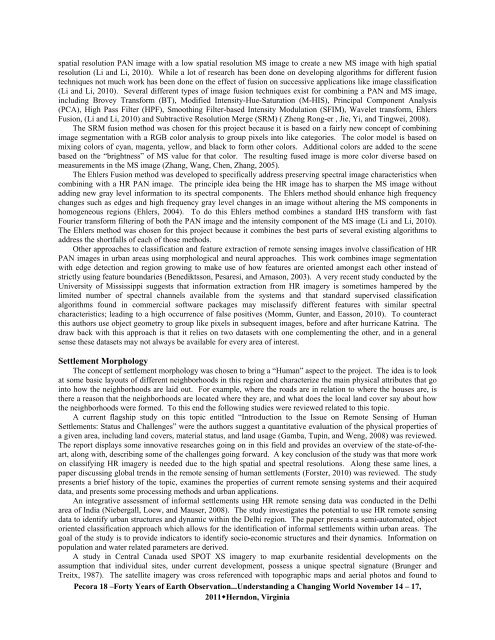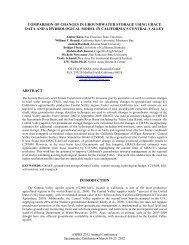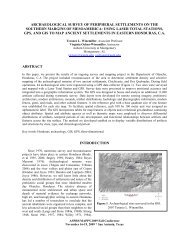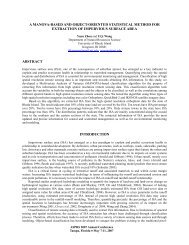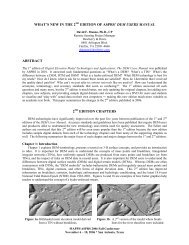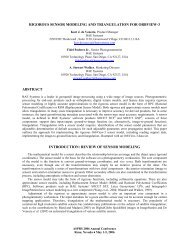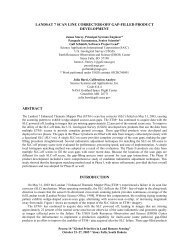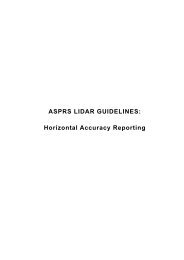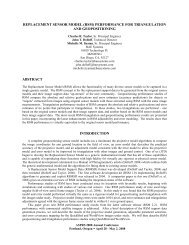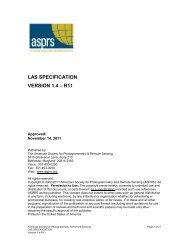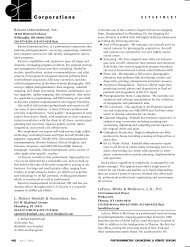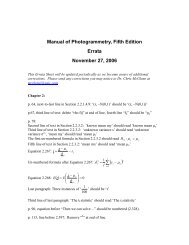using image fusion and classification to profile a human ... - asprs
using image fusion and classification to profile a human ... - asprs
using image fusion and classification to profile a human ... - asprs
Create successful ePaper yourself
Turn your PDF publications into a flip-book with our unique Google optimized e-Paper software.
spatial resolution PAN <strong>image</strong> with a low spatial resolution MS <strong>image</strong> <strong>to</strong> create a new MS <strong>image</strong> with high spatial<br />
resolution (Li <strong>and</strong> Li, 2010). While a lot of research has been done on developing algorithms for different <strong>fusion</strong><br />
techniques not much work has been done on the effect of <strong>fusion</strong> on successive applications like <strong>image</strong> <strong>classification</strong><br />
(Li <strong>and</strong> Li, 2010). Several different types of <strong>image</strong> <strong>fusion</strong> techniques exist for combining a PAN <strong>and</strong> MS <strong>image</strong>,<br />
including Brovey Transform (BT), Modified Intensity-Hue-Saturation (M-HIS), Principal Component Analysis<br />
(PCA), High Pass Filter (HPF), Smoothing Filter-based Intensity Modulation (SFIM), Wavelet transform, Ehlers<br />
Fusion, (Li <strong>and</strong> Li, 2010) <strong>and</strong> Subtractive Resolution Merge (SRM) ( Zheng Rong-er , Jie, Yi, <strong>and</strong> Tingwei, 2008).<br />
The SRM <strong>fusion</strong> method was chosen for this project because it is based on a fairly new concept of combining<br />
<strong>image</strong> segmentation with a RGB color analysis <strong>to</strong> group pixels in<strong>to</strong> like categories. The color model is based on<br />
mixing colors of cyan, magenta, yellow, <strong>and</strong> black <strong>to</strong> form other colors. Additional colors are added <strong>to</strong> the scene<br />
based on the “brightness” of MS value for that color. The resulting fused <strong>image</strong> is more color diverse based on<br />
measurements in the MS <strong>image</strong> (Zhang, Wang, Chen, Zhang, 2005).<br />
The Ehlers Fusion method was developed <strong>to</strong> specifically address preserving spectral <strong>image</strong> characteristics when<br />
combining with a HR PAN <strong>image</strong>. The principle idea being the HR <strong>image</strong> has <strong>to</strong> sharpen the MS <strong>image</strong> without<br />
adding new gray level information <strong>to</strong> its spectral components. The Ehlers method should enhance high frequency<br />
changes such as edges <strong>and</strong> high frequency gray level changes in an <strong>image</strong> without altering the MS components in<br />
homogeneous regions (Ehlers, 2004). To do this Ehlers method combines a st<strong>and</strong>ard IHS transform with fast<br />
Fourier transform filtering of both the PAN <strong>image</strong> <strong>and</strong> the intensity component of the MS <strong>image</strong> (Li <strong>and</strong> Li, 2010).<br />
The Ehlers method was chosen for this project because it combines the best parts of several existing algorithms <strong>to</strong><br />
address the shortfalls of each of those methods.<br />
Other approaches <strong>to</strong> <strong>classification</strong> <strong>and</strong> feature extraction of remote sensing <strong>image</strong>s involve <strong>classification</strong> of HR<br />
PAN <strong>image</strong>s in urban areas <strong>using</strong> morphological <strong>and</strong> neural approaches. This work combines <strong>image</strong> segmentation<br />
with edge detection <strong>and</strong> region growing <strong>to</strong> make use of how features are oriented amongst each other instead of<br />
strictly <strong>using</strong> feature boundaries (Benediktsson, Pesaresi, <strong>and</strong> Arnason, 2003). A very recent study conducted by the<br />
University of Mississippi suggests that information extraction from HR <strong>image</strong>ry is sometimes hampered by the<br />
limited number of spectral channels available from the systems <strong>and</strong> that st<strong>and</strong>ard supervised <strong>classification</strong><br />
algorithms found in commercial software packages may misclassify different features with similar spectral<br />
characteristics; leading <strong>to</strong> a high occurrence of false positives (Momm, Gunter, <strong>and</strong> Easson, 2010). To counteract<br />
this authors use object geometry <strong>to</strong> group like pixels in subsequent <strong>image</strong>s, before <strong>and</strong> after hurricane Katrina. The<br />
draw back with this approach is that it relies on two datasets with one complementing the other, <strong>and</strong> in a general<br />
sense these datasets may not always be available for every area of interest.<br />
Settlement Morphology<br />
The concept of settlement morphology was chosen <strong>to</strong> bring a “Human” aspect <strong>to</strong> the project. The idea is <strong>to</strong> look<br />
at some basic layouts of different neighborhoods in this region <strong>and</strong> characterize the main physical attributes that go<br />
in<strong>to</strong> how the neighborhoods are laid out. For example, where the roads are in relation <strong>to</strong> where the houses are, is<br />
there a reason that the neighborhoods are located where they are, <strong>and</strong> what does the local l<strong>and</strong> cover say about how<br />
the neighborhoods were formed. To this end the following studies were reviewed related <strong>to</strong> this <strong>to</strong>pic.<br />
A current flagship study on this <strong>to</strong>pic entitled “Introduction <strong>to</strong> the Issue on Remote Sensing of Human<br />
Settlements: Status <strong>and</strong> Challenges” were the authors suggest a quantitative evaluation of the physical properties of<br />
a given area, including l<strong>and</strong> covers, material status, <strong>and</strong> l<strong>and</strong> usage (Gamba, Tupin, <strong>and</strong> Weng, 2008) was reviewed.<br />
The report displays some innovative researches going on in this field <strong>and</strong> provides an overview of the state-of-theart,<br />
along with, describing some of the challenges going forward. A key conclusion of the study was that more work<br />
on classifying HR <strong>image</strong>ry is needed due <strong>to</strong> the high spatial <strong>and</strong> spectral resolutions. Along these same lines, a<br />
paper discussing global trends in the remote sensing of <strong>human</strong> settlements (Forster, 2010) was reviewed. The study<br />
presents a brief his<strong>to</strong>ry of the <strong>to</strong>pic, examines the properties of current remote sensing systems <strong>and</strong> their acquired<br />
data, <strong>and</strong> presents some processing methods <strong>and</strong> urban applications.<br />
An integrative assessment of informal settlements <strong>using</strong> HR remote sensing data was conducted in the Delhi<br />
area of India (Niebergall, Loew, <strong>and</strong> Mauser, 2008). The study investigates the potential <strong>to</strong> use HR remote sensing<br />
data <strong>to</strong> identify urban structures <strong>and</strong> dynamic within the Delhi region. The paper presents a semi-au<strong>to</strong>mated, object<br />
oriented <strong>classification</strong> approach which allows for the identification of informal settlements within urban areas. The<br />
goal of the study is <strong>to</strong> provide indica<strong>to</strong>rs <strong>to</strong> identify socio-economic structures <strong>and</strong> their dynamics. Information on<br />
population <strong>and</strong> water related parameters are derived.<br />
A study in Central Canada used SPOT XS <strong>image</strong>ry <strong>to</strong> map exurbanite residential developments on the<br />
assumption that individual sites, under current development, possess a unique spectral signature (Brunger <strong>and</strong><br />
Treitx, 1987). The satellite <strong>image</strong>ry was cross referenced with <strong>to</strong>pographic maps <strong>and</strong> aerial pho<strong>to</strong>s <strong>and</strong> found <strong>to</strong><br />
Pecora 18 –Forty Years of Earth Observation...Underst<strong>and</strong>ing a Changing World November 14 – 17,<br />
2011Herndon, Virginia


